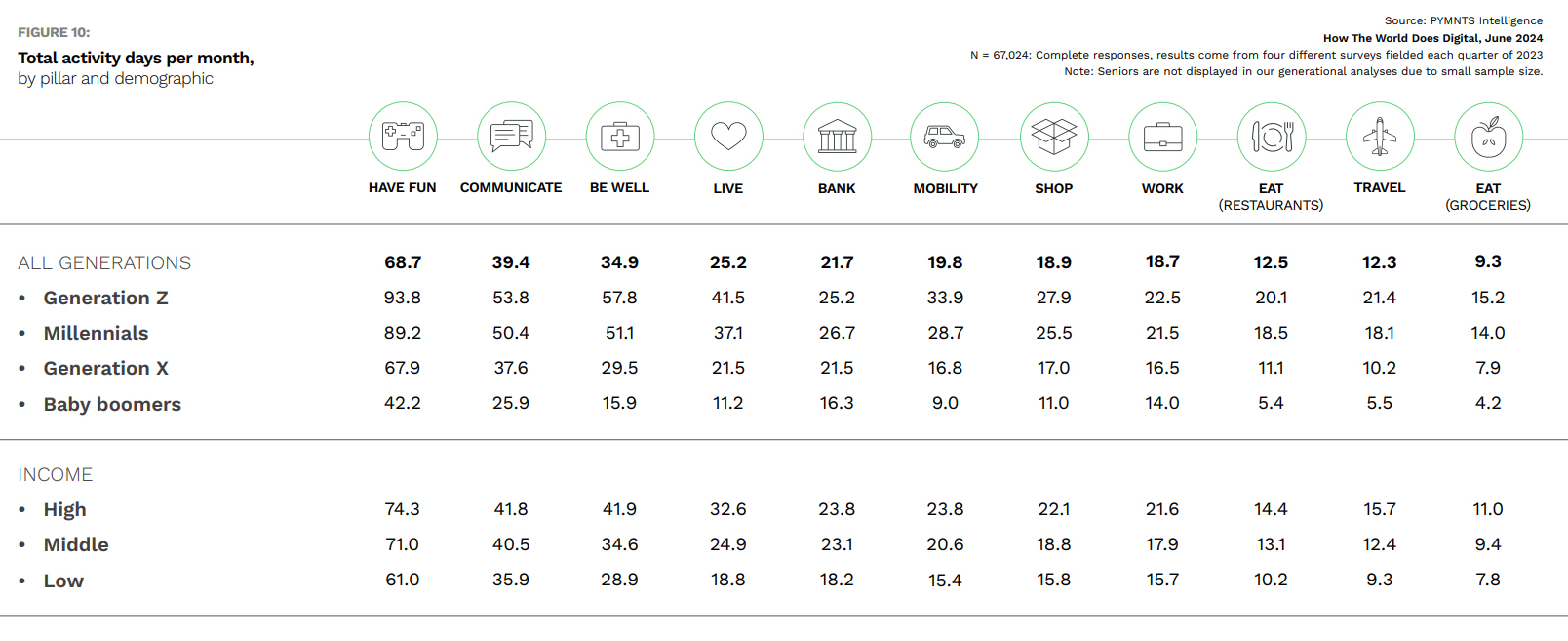In an era defined by rapid technological evolution, each generation brings its own distinct approach to digital engagement.
This insight emerges from the PYMNTS Intelligence report, “How The World Does Digital,” which dives deep into global generational habits, offering critical guidance for businesses shaping their digital strategies.

Generation Z, born between the mid-1990s and early 2010s, epitomizes seamless connectivity and digital immersion.
For these digital natives, social interaction flows effortlessly through platforms like Snapchat andTikTok, where messaging and social media are integral to their daily lives. Gen Zers consume entertainment avidly through video streaming and mobile gaming, while also embracing personalized digital shopping experiences. Though health apps are emerging, their focus remains on maintaining a dynamic digital lifestyle.
Gen Zers recorded the high mark for most activity days per month with an average of 93.8 in the “Have Fun” pillar. Their next two highest activity pillars are “Be Well” (57.8 days) and “Communicate” (53.8 days).
Millennials, spanning from the early 1980s to the mid-1990s, were the pioneers of widespread digital adoption. They pioneered digital banking and mobile finance, integrating these tools into their daily routines alongside ridesharing and online travel services. Their work and shopping habits have shifted decisively online, leveraging remote collaboration tools and eCommerce platforms for both professional and personal needs.
Advertisement: Scroll to Continue
Despite their digital prowess, millennials maintain a balanced media diet that includes both streaming services and traditional media. Millennials also scored high in the “Have Fun” pillar with an average of 89.2 activity days per month. Their next two highest activity pillars were also “Be Well” (51.1 days) and “Communicate” (50.4 days).
Generation X, born from the mid-1960s to the early 1980s, approaches digital technology pragmatically.
Gen Xers are drawn to digital banking and increasingly turn to telemedicine and fitness apps for health management. Online platforms supplement their shopping and travel planning, blending convenience with established habits. Gen Xers engage with digital streaming while still holding onto traditional media, reflecting their practical and hybrid approach to entertainment.
Gen Xers had a little less fun but still recorded 67.9 activity days per month in the “Have Fun” pillar, followed by “Communicate” (37.6 days) and “Be Well” (29.5 days).
Baby boomers, born from the mid-1940s to the mid-1960s, engage with digital tools driven by necessity and convenience. They primarily use email for digital communication but are gradually adopting messaging apps and digital banking. Health and entertainment are increasingly digitalized, with telemedicine and streaming services becoming essential parts of their lifestyles.
eCommerce is gaining traction among this demographic, providing them with convenience and an expanded range of options. Health and entertainment are increasingly digitalized, with telemedicine and streaming services becoming essential parts of their lifestyles. For baby boomers, their highest activity pillar was “Have Fun” (42.2 days), followed by “Communicate” (25.9 days), and “Bank” (16.3 days).
Understanding these distinct engagement patterns across generations is crucial for businesses navigating today’s dynamic marketplace. By recognizing and adapting to these evolving digital behaviors, businesses can craft strategies that resonate effectively across all demographics, ensuring relevance and success in an increasingly digital world.
The study encompassed 11 countries representing a total population of 817 million, including major developed economies with robust digital infrastructure and emerging innovators like Brazil and Singapore. These nations collectively represented nearly half of global GDP in 2022.
Using third-party online panels, researchers ensured samples reflected each country’s demographics, targeting large cohorts in the U.S. and substantial groups in others. Quarterly surveys yielded sizable responses, enabling precise insights into digital activities across various demographics.
In 2023, more than 67,000 consumers participated, offering a comprehensive view across 11 key aspects of digital life, distilled from an initial 70 activities to 40 commonly engaged ones. The analysis gauged frequency of engagement, crucial for understanding digital adoption, but not easily comparable across categories or nations due to varying activity scales.
To address this, researchers estimated monthly engagement days for each activity, allowing for comprehensive summaries and an index measuring digital engagement. Results focused on adults aged 18-77 to ensure generational relevance. Overall, findings were weighted by population to ensure statistical validity, providing a nuanced perspective on global digital behaviors.

